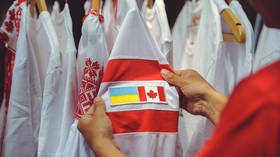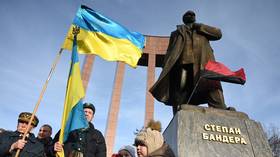Secret KGB documents reveal horror crimes of Ukrainian Nazi collaborators
Ukrainian nationalists began ethnic cleansing of Jews during WWII, even before the actual Nazi occupation began, documents show
RT has obtained a trove of declassified documents from the KGB, highlighting crimes committed by Ukrainian nationalists in Soviet territories occupied by Nazi Germany during WWII. The documents include witness accounts of people who survived ethnic cleansings, as well as testimonies of Ukrainian collaborators captured by the Soviet domestic intelligence, then known as the NKVD.
Large swaths of present-day Ukraine fell under Nazi occupation in summer 1941 as German troops advanced deep into the Soviet Union. In fact, attacks on ethnic Jews and Poles, as well as local communists, began immediately as Soviet troops withdrew.
“In the first hours following the retreat of the Bolsheviks, the Ukrainian population has demonstrated commendable activity against Jews,” a status report from the Gestapo, Nazi Germany’s secret police, dated July 16, 1941, reads.
Said “commendable activities” involved burning down a synagogue in the western Ukrainian city of Dobromyl and the murder of some 50 Jews by an “angry crowd” in Sambor. In Sokal, the help of local “trustworthy Ukrainians” allowed Nazis to find and exterminate some 183 “communist Jews.” Moreover, Ukrainian nationalists rounded up and brutally abused around 1,000 Jews in Lvov, subsequently putting them into a local prison, with the facility and the ‘inmates’ eventually taken over by the Germans, according to the status report.
With the German occupation regime properly established, the ethnic cleansing process was streamlined, with the so-called Ukrainian Auxiliary Police, created by the Nazis in August 1941, playing a very active role in it. According to the testimony of the Ukrainian police commander in Belya Tserkov, a major city in the Kiev region, Mikhail Tomasevish, members of his unit were so eager to kill Jews that they acted even beyond orders given by their Nazi masters. Namely, the local police secretary took pleasure in “questioning” arrested Jews, beating them with a rubber tube, and freely taking them “away” afterwards, with none of the detained ever returning to the police HQ.
Tomasevich led the police unit until 1943, when he fled alongside retreating German forces but ultimately ended up in the NKVD’s custody. While Tomasevich claimed most of the city’s Jews were exterminated before he assumed the post, he admitted partaking, one way or another, in the killing of over 1,000 people. Under his leadership, the police continued to actively search for survivors, using various tricks to lure the remaining Jews in the city to their deaths.
“To identify hiding persons of Jewish nationality, the [German field] gendarmerie, through the [Ukrainian] police, organized so-called traps, i.e., it was announced throughout the city that henceforth Jews would be allowed to live freely, but only in select houses,” Tomasevich testified.
“I put all the Jews who believed that and settled in the houses on a special register, a special folder of cases, titled ‘Yids’ [a derogatory term for ‘Jews’], was opened,” he explained, adding that when the flow of Jews willing to settle in the houses waned, all of them, some 50 people, were detained and killed “around January or February 1942.”
Civilian Ukrainian authorities, established under German occupation, have actively contributed to ethnic cleansings as well. For instance, according to an indictment in a 1944 case about Nazi crimes committed in the city of Sarny and its vicinity, local Ukrainian mayor Marinyuk directly facilitated the extermination of the entire local Jewish population in August 1942.
Some 13,000 people were gathered at a local concentration camp, guarded by field gendarmerie and Ukrainian police, under the pretext of being relocated for “work” in Germany. Instead, the Jews ended up before firing squads, with children thrown into the death pits and buried alive. Only some 40–50 people managed to escape the massacre, with Ukrainian nationalist units in pursuit, and those who managed to capture escapees were awarded a sack of salt.







Comments are closed.